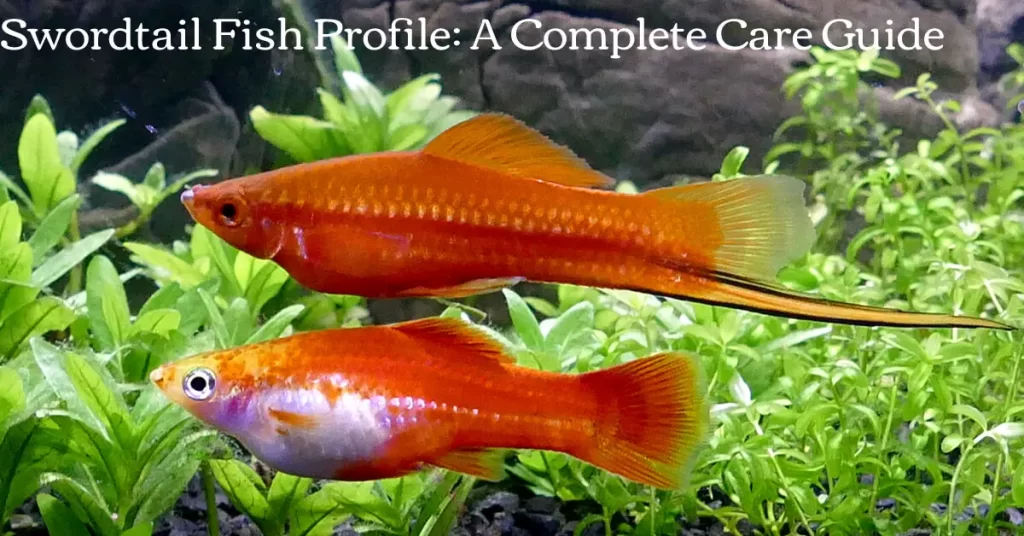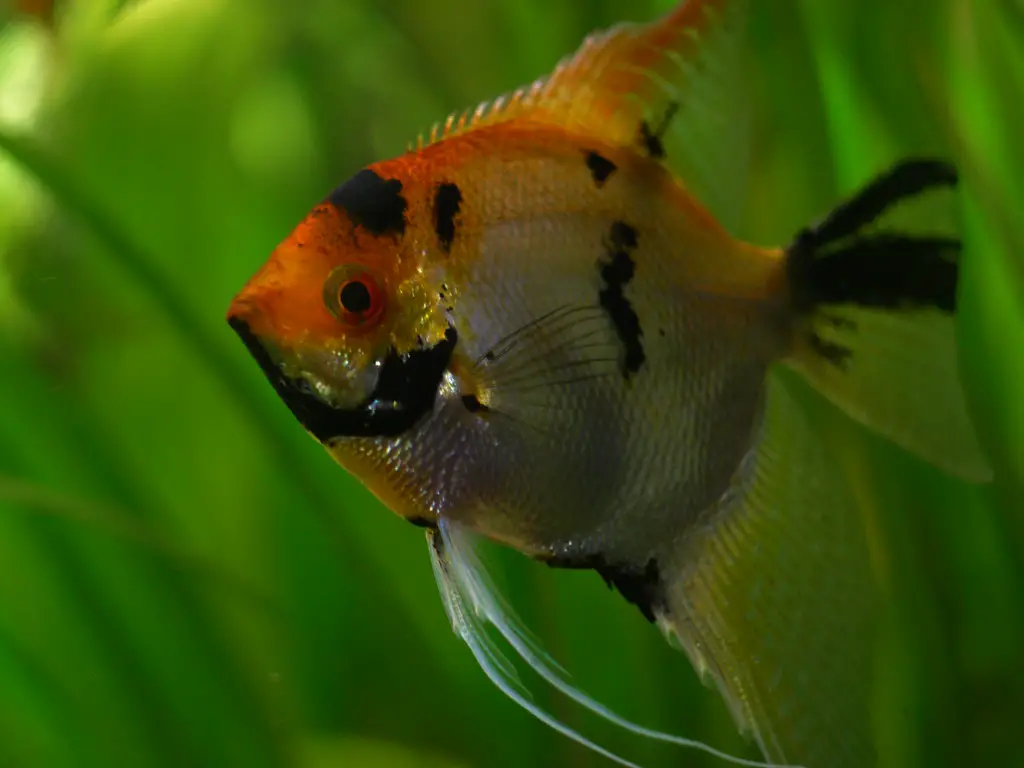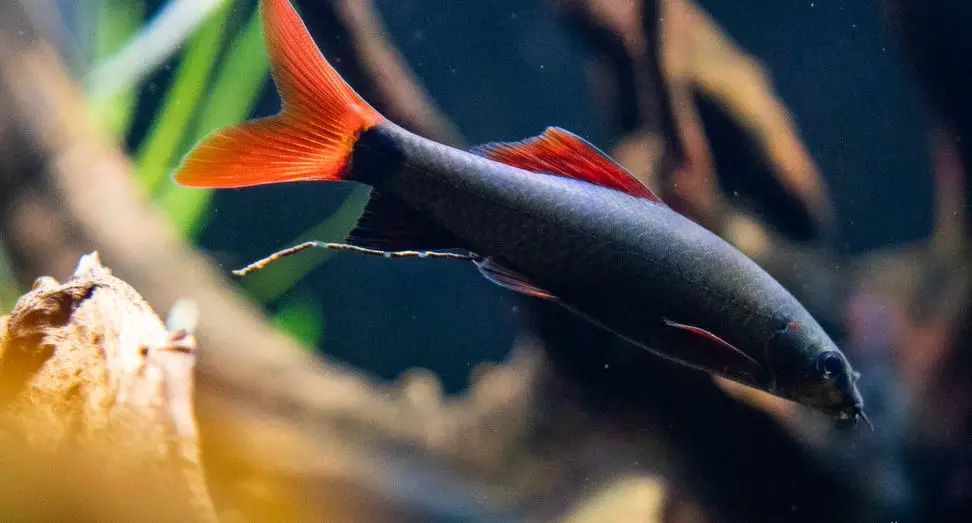Every beginner’s first concern is how they can ace what they are getting into. The same goes for the new fish-keeping hobbyists. Aquarium fishkeeping has become a popular hobby among millennials today. If you belong to this group, this might be just the right article for you.
As a newbie, your dismay must have been the choice of your fish. What better way to start the amazing journey than with Swordtail Fish? Swordtail Fish is an excellent choice not only for new-timers but also for the old ones if they want a new addition. They are peaceful, hardy, and adaptable community fish, which is why swordtail fish care is such a simple task.
This article will guide you on how to take proper care of swordtail breeds, but before that, it is important to have general knowledge about the fish.
Quick Swordtail Fish Care Guide
| Experience Level | Beginner – Easy to care for, hardy fish, easy to breed, and are undemanding |
| Appearance | Small and elongated, males have a sword-like tail extension and an anal fin. Females lack those and have rounded tails. |
| Adult Size | Male Swordtail Adult Size: 5.5” Female Swordtail Adult Size: 6”(an inch longer than males) |
| Water Condition | Hard, Alkaline water(12-30dGH)
Freshwater |
| Water Temperature Range | 65-80 Degree Fahrenheit |
| Tank Region | Usually found dwelling along the mid and top section of the tank |
| Tank Size | At least 15-gallon (45L) or larger |
| Food | Omnivorous (Algae, Bloodworms, Baby shrimps, etc.) |
| Lifespan | 3-5 years |
Swordtail Fish General Description:
Swordtail fish (Xiphophorus helleri) are popular freshwater species belonging to the Poeciliidae family. They are livebearers which means they do not lay eggs. Hence, swordtails give birth to live fry. There are currently 17 to 18 known species of swordtail that are bred and inter-bred into a variety of colors making it one of the most exotic options.
Swordtail Fish Appearance
What makes swordtails unique from other fish is their appearance. The most apparent feature is the caudal fin of male fish. Their tail has a protrusion in a shape of a sword on the lower lobe, hence the name. However, the sword is absent in females.
Swordtail Lifespan
The average lifespan of swordtail fish is around 3-5 years. Given they are kept in a healthy environment with proper care, the fish tend to live longer. Although, different diseases and genetic issues may alter the span.
Likewise, swordtail fish are medium-sized fish measuring about 5.5 inches in length when fully grown. But, female fish are often about an inch longer than males.
Availability
Swordtail fish are easily found in all freshwater resources around Central and Northern America. These fish are among the most popular ornamental fish around the globe. Hence, they are easily purchasable in your local aquarium store.
Price
There are varieties of swordtail fish found in the market. Fish of different colors and patterns makes them attractive, hence, expensive. The price depends on the fish you are trying to purchase. however, it may range from $3 to $15.
Sexual Difference
As mentioned above, the major difference seen between a male and a female swordtail is their tail. Only males have the tail extension whereas females have rounded caudal fins. Also, Female bodies are more elongated and fuller at maturity.
Another difference is that male fish possess a long and thin gonopodium, also known as anal fin used for mating. In female fish, the anal fin is comparatively long, thick and, triangular in shape.
Swordtail Fish Care Guide
Swordtail fish are easy to care for and are suitable for novice aquarists as well. They can survive in diverse environments and are undemanding. The care guidelines are given below:
Tank Size
Swordtail fish are average-sized fish, so they do not need much space. But, since they are active swimmers, it is best to give them enough space to swim around. A 15-Gallon tank can be a good start. This means 15-Gallon tank space for a single fish. If you plan on keeping other fish in the tank, you should aim for a tank not less than 30-Gallon.
If you get a tank of a minimum 30-Gallon capacity, it will give enough space for your swordtail to swim around and explore. Meanwhile, there will be plenty of comfortable space for additional fish to thrive.
Water Parameters
The water conditions to be maintained for swordtail fish in the tank are:
- Water pH: anywhere between 7.0-8.4
- Water Hardness: 12-30 DH
- Temperature: 65-80°F (21-28°C)
Tank Decorations
In the wild, they are mostly found in freshwater bodies of North and Central America including Belize, Guatemala, and Mexico. Naturally, they would be surrounded by tropical flowing water, plenty of vegetation, and rocks and debris.
Although swordtails are hardy fish, it is best if they are introduced to their natural setup in the tank. Most important things that swordtail fish needs are space and some plants for hiding.
Moreover, swordtails are active and they swim around the mid and surface level of the plant. For this reason, the substrate should not be your biggest concern. You can choose the substrate that is suitable for other bottom-dwellers in your tank.
If there are no other kinds of fish in your tank, the sandy substrate can be the best choice as found in their natural habitat. You can also use some rocks and driftwoods to provide them additional shelter.
Likewise, plants that you put in your tank should be your main focus. The natural habitat of this fish is thickly planted. They use the vegetation for hiding from other fish, from the sunlight, and when they are stressed.
Use plants that provide safe spaces for the fish. You can use either artificial or live plants, but live plants help keep your aquarium healthy. Java fern, Anubis, etc are some popular choices. Spread your plants around the aquarium leaving enough space for them to swim around.
Swordtail is not only active explorers but also powerful jumpers. Thus, a strong tank lid can be a crucial add-on to prevent adversity.
Tank Lighting
Swordtail fish are freshwater species found in streams and other smaller water bodies. They are accustomed to bright and warm sun rays. Replicating natural habitat for the swordtail fish will include comparatively heavy plantation. Choosing a bright lighting system with a color temperature between 6700k to 10000k would be ideal for both the fish and vegetation to flourish.
Food And Diet For Swordtail Fish
Swordtail fish will virtually eat anything which makes their diet care easier. They are natural omnivores and prefer both plants and proteins.
Similarly, swordtail juveniles need a proper amount of protein and fibers for speedy and healthy development. Make sure to provide them with high-quality supplements of small size containing both plant-based and meat-based nutrients.
Best food for Swordtail Fish:
You can provide your swordtail with quality flake food or live foods like bloodworms, blackworms, daphnia, and brine shrimp, and mosquito larvae. Their taste in frozen food is almost similar and they can be fed frozen supplements too. Ensure to add some plant-based nutrients like algae wafers as they also prefer herbivorous nutrients.
They are small fish and feeding them in a small amount a couple of times a day will suffice.
Possible Diseases That Swordtail Fish Suffers From
Swordtail fish are livebearers. Tank-raised livebearers hardly get sick given they are kept in a healthy aquarium. Nevertheless, this does not mean they are immune to diseases. Like all livebearers, swordtail fish are also susceptible to common ailments.
White spot or Ich is among the common diseases. It is caused by ectoparasite that ruins a fish’s immune system. The signs of this disease are white spots all over the body and fins of the fish.
Diagnosis: Raise the temperature to about 85F, add some salt, set up a quarantine tank for the infected fish, and use necessary medication.
Similarly, Cottonmouth; recognized by white fluffy growths around the mouth or fins, is another common possible disease.
Diagnosis: Treat fish with maracyn or some antibiotics.
Furthermore; Fin Rot, Intestinal parasites, Cloudy Skin are a few other common possible diseases that a swordtail fish can suffer from. The best way to avoid these diseases is to closely monitor the tank conditions. Major fluctuations in temperature, high levels of ammonia and nitrate can increase the risk of infection.
How to maintain water Parameter/Quality For Swordtail Fish
Setting the right water temperature, pH and hardness are very crucial for a fish’s growth and its healthy living and breeding. A sudden drop in these parameters can cause serious harm to the fish.
Water Temperature
Swordtail fish are naturally found in freshwater bodies. Being hardy does make them tolerable to a wide range of temperatures. However, 65-820F is suitable.
You can maintain this temperature by covering the tank with a lid or a hood. Use a thermometer to monitor the temperature regularly. The use of stronger lights and insulation layers, or heaters can help your water stay warm.
Water Ph and Hardness
It is crucial to maintain the pH and the hardness of water to let the fish in your tank thrive. Water hardness can be simply described as the mineral levels in the water. Hard water has a high dissolved mineral content.
You can maintain the required hardness by adding minerals to your water. Keeping up with your regular water changes, using a water remineralizer, or corals containing calcium or magnesium can help you reach your required GH.
Water Filtration
Regular filtration of water cleans the surplus waste in the water, removes toxins like ammonia and nitrate, and helps your fish breathe. There are various aquarium filters available to make this job a whole lot easier for you.
With swordtail fish, you can run your tank without any filters but you have to clean your water and add a lot of live pants to compensate for it. Keep track of your water parameters so that your fish can live to the fullest.
Water Change Is the Key To Aquarium Water Maintenance
You have to make sure you change and filtrate your water regularly prevents sickness and infection and promotes breeding. Changing your water is vital to maintain good water quality. Changing 25% of the tank water every month can be a start to maintaining the quality of water. Water change contributes to the removal of nitrogenous pollutants, decomposing waste matter prevents clouding of water, all of which is vital to maintain a healthy aquarium.
Temperament (Social Behavior)
Swordtail fish are excellent community fish. They are social and enjoy good company. Keeping swordtail fish is more manageable because they are quite peaceful and friendly. They like to interact with other fish while exploring the tank. While they are not a shoaling species, they still prefer to stay in groups periodically.
However, there is a possibility of aggression; especially among males. If you have multiple males in the same tank, they are likely to show aggression among each other due to their territorial nature. Maintaining a higher ratio of females (approximately 4 females to 1 male) is necessary to maintain peace in the tank.
Swordtail Fish Tankmates
Swordtail fish are social and get along with almost all similar species, and can also live comfortably with many different ones. Since they are peaceful and friendly, it is preferable to put them together with similar passive fish.
They could make a great companion with Platies, Mollies, Guppies, Betta, Angelfish, Tetras, Dwarf Gouramis, Pearl Danios, Kuli Loaches, and many other species which have similar temperaments you could pair them with other swordtail fishes.
But as mentioned above, it is better not to keep two male swordfish in the same tank to prevent fights and injuries. Also, four females to one male as the same number of males and females can lead to harassment of the female.
Certainly, avoiding fish that are aggressive and bully is important. Hence, most cichlids are out of the question. Aggressors tend to make swordtail fish timid which could lead to stress or even death.
Breeding
Swordtail fish give birth to live fry. They breed efficiently and quickly, without the help of their owners. Swordtail becomes reproductive at the age of 3-4 months. In favorable conditions, females can give birth once every 28 days, producing 50-100 fry every time. Female swordtails can keep sperm cells inside their pouch and fertilize even in absence of males.
Breeding Process
A slight increase in the water temperature up to 83F, clean tanks, and a healthy diet can facilitate the breeding process.
And, when ready the fish will spawn. During mating, the males will swim next to the females and try to nip them. This can be stressful for the female. Thus, maintaining the 3:1 ratio is crucial; 3 female to 1 male.
Similarly, a pregnant female will limit all movements and hide in a corner. Females will start to swell at their bellies with eggs which will be the quite visible gravid spots. When the spot gets darker and fish becomes visibly fat, they are ready to give birth. The dark spots are fry eyes that you can see through.
Is it necessary to set up a breeding tank?
Yes, it is recommended that you set up a separate breeding tank.
The swordtail can easily breed in the primary tank but it is a good idea to provide a separate tank to increase the chances of survival of the fry.
However, there are chances that other tank mates or the parents themselves consume the fry. To prevent that from happening, transfer the pair into a separate tank for breeding. Once the spawning takes place, it is better if you remove the adults from the tank. This is because adult swordfish do not have parental instincts and can easily confuse their fry for food.
In addition, you should be extra careful with juveniles. They are active and hungry. You can feed them smaller chunks of regular swordfish supplements.
Swordtail Fish Keeping Difficulty
Swordtail fish care is nothing heavy. Their hardy and adapting nature makes their care an easy task. These freshwater species are not troublesome and can be a perfect choice for beginners as well.
As long as you follow the basic requirements, taking care of the fish should be a piece of cake.
I sincerely hope this guide was helpful and it encouraged you to give this wonderful fish a thought.






